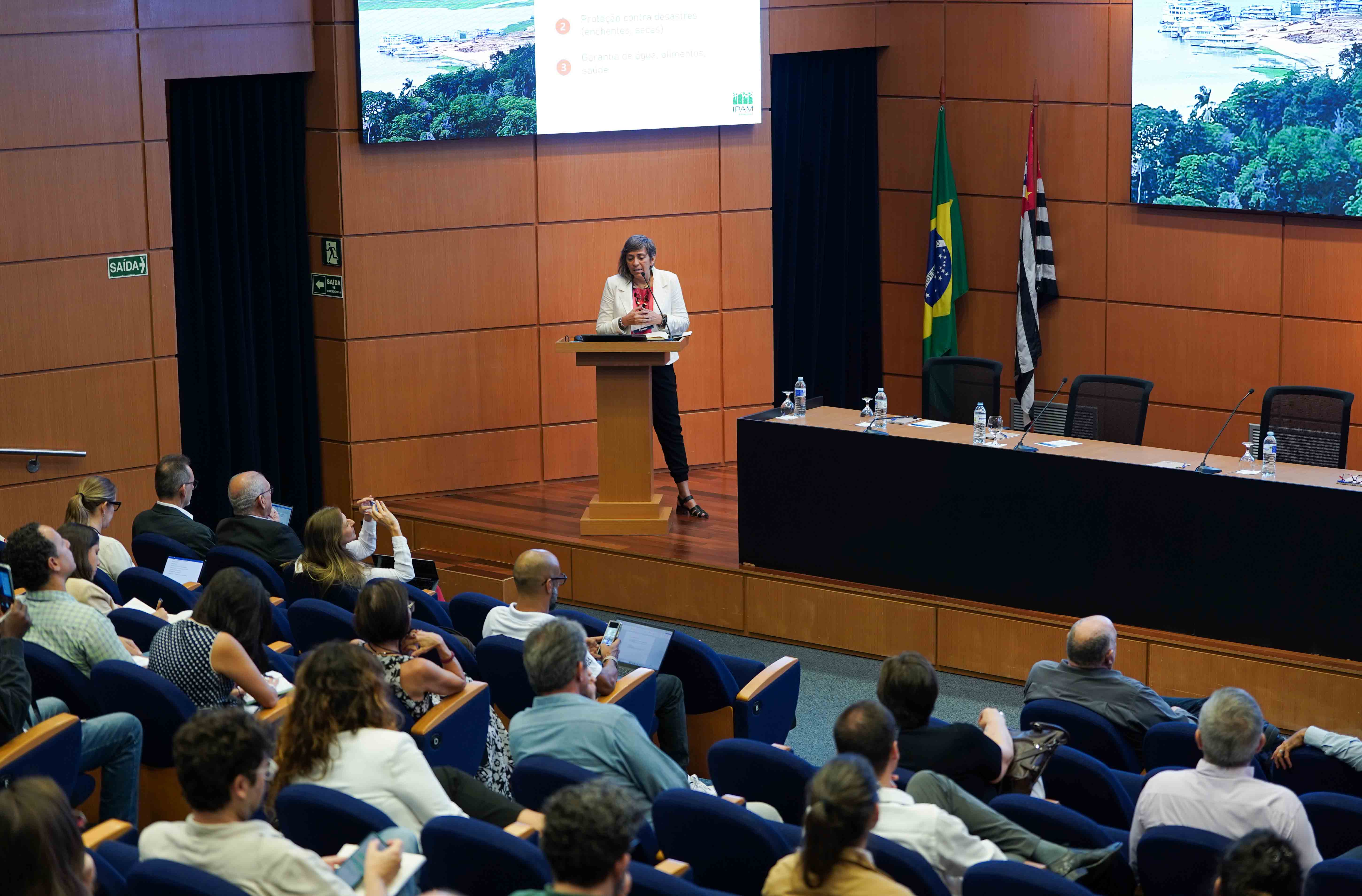


Alencar: “Biodiversity is the basis of ecosystem services, which keep our lives functioning” (photo: Daniel Antônio/Agência FAPESP)
Published on 04/14/2025
By Maria Fernanda Ziegler | Agência FAPESP – At the same time as being strongly affected by climate change, biodiversity is also important in combating the problem. While extreme weather events have caused the displacement and reduction of species, it is the so-called ecosystem services and nature-based solutions – both of which depend on healthy biodiversity – that can guarantee the transformations proposed in the climate crisis adaptation and mitigation agendas.
“Biodiversity is the basis of ecosystem services, which keep our lives functioning. It regulates water, climate, soil, pollination and food security. Therefore, biodiversity is linked to the climate mitigation and adaptation agenda, and also to the climate justice agenda [related to the fact that the impacts of climate change affect different social groups in different ways and with different intensities],” said Ane Alencar, Science Director at the Amazon Environmental Research Institute (IPAM).
The researcher spoke about the need to better integrate biodiversity into the climate agenda during the conference “Contributions to COP-30: Biodiversity in the Climate Agenda,” which kicked off the FAPESP Conferences 2025 series on March 28th.
“Ecosystems play a fundamental role in absorbing and removing CO2 [carbon dioxide] from the atmosphere. So avoiding deforestation reduces greenhouse gas emissions. And restoring ecosystems results in the reduction of carbon from the atmosphere – an important effect in mitigating climate change,” she added.
In terms of the adaptation agenda, Alencar pointed out that solutions such as the restoration of hillsides, for example, protect against disasters and guarantee quality water and food that can be produced with a minimum of herbicides – which has a positive impact on human health.
Debate with the scientific community
The event also brought together experts and members of the scientific committees of some of the Foundation’s thematic programs, such as the FAPESP Program for the South Atlantic and Antarctica (PROASA), the FAPESP Program for Research on Global Climate Change (RPGCC), the FAPESP Research Program on Characterization, Conservation, Restoration and Sustainable Use of Biodiversity (BIOTA) and the Amazon+10 Initiative, to discuss and reflect on the scientific community’s strategies for the United Nations Conference on Climate Change (COP-30), which will be held in Belém, the capital of the Amazonian state of Pará, in November.
Simone Vieira, a researcher at the Center for Environmental Studies and Research of the State University of Campinas (NEPAM-UNICAMP) and a member of the BIOTA coordination team, pointed out that the word biodiversity is mentioned only three times in the letter sent to the international community by the President of COP-30, Ambassador André Corrêa do Lago.
The 11-page document, released on March 10th, sets out the Brazilian Presidency’s vision for the COP-30 process and calls on all countries to work together against climate change.
“It turns out that there’s no climate without biodiversity. It’s biodiversity that produces climate, and climate structures biodiversity. So you can’t separate one from the other,” Vieira said.
According to Carlos Joly, Professor Emeritus at UNICAMP, the principle of “common and differentiated responsibility” for climate change, which is the basis of the negotiations held under the United Nations Framework Convention on Climate Change, is the subject of dispute between the representatives of developed and developing countries in the Forum.
The concept established at Rio-92 calls for greater participation (in funding) by developed countries, which have historically produced most of the CO2 in the atmosphere. However, the same concept does not exist in the area of biodiversity.
According to Joly, there have been discussions about integrating climate and biodiversity into the debate for at least 20 years, because it is known that the two agendas need to be linked. “Brazil isn’t the only country with this separate vision. There are others that have also blocked the possibility of holding joint COPs or creating joint working groups between representatives of the different conventions,” he said.
The Intergovernmental Panel on Climate Change (IPCC) and the Intergovernmental Platform on Biodiversity and Ecosystem Services (IPBES) – scientific bodies that produce reports on the state of the climate and biodiversity, respectively, to inform policy-making – organized a joint workshop and produced reports that show how the two agendas are intertwined.
“However, the report had to be accepted by the plenary sessions of the countries, and Brazil opposed the approval of the document because it combined the two issues. Brazil authorized the take note, in other words, it acknowledged that the document existed, but sent it to the shelf,” he reported.
Alencar warned that one of the consequences of separating climate and biodiversity in environmental discussions is the failure to include forest fires among the commitments Brazil is expected to make at COP-30.
“Forest fires are not included in the inventory of greenhouse gas emissions. They’re considered a natural problem worldwide. But forest fires in tropical forests aren’t natural. Of course, they can be exacerbated by a climatic phenomenon, as they were in 2024. But this is an agenda that we have to take to COP-30, because there’s an increase in fires in the Amazon, and 65% of the fire emissions are late. And after it passes, the trees die,” said the researcher.
COP-30 will also be highlighted in five other FAPESP conferences already scheduled for this year, which will be presented by David Obura (IPBES), on April 25th, Ima Vieira (Emilio Goeldi Museum of Pará) from Belém on April 29th, Thelma Krug (IPCC) on May 30th, Denise Duarte (University of São Paulo – USP) on June 27th, and Helena Nader (Brazilian Academy of Sciences – ABC) on August 29th.
The March 28th event can be viewed in its entirety at: www.youtube.com/watch?v=rcn9iQTnccE.
Source: https://agencia.fapesp.br/54487